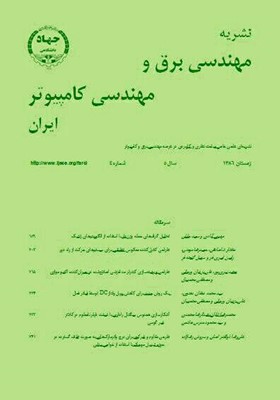طرحي مقاوم و غيركور براي درج واترماركهاي به صورت طيف گسترده در حوزه تبديل موجك با استفاده از خواص بينايي
محورهای موضوعی : مهندسی برق و کامپیوترعلیرضا ذوالقدر اصلی 1 * , سروش رضازاده 2
1 - دانشگاه شیراز
2 - دانشگاه شیراز
کلید واژه: واترماركواترمارك غير كورتبديل موجكخواص بينايي انسان (HVS),
چکیده مقاله :
در اين مقاله ما يك روش واترماركينگ مقاوم به منظور حفاظت از حق كپي تصاوير معرفي ميكنيم. اين روش بر مبناي اصول چندوضوحي تصوير استوار است و از تبديل موجك گسسته (DWT) استفاده ميكند. واترمارك مورد استفاده يك رشته از اعداد تصادفي با توزيع نرمال ميباشد. براي اينكه بتوانيم واترمارك را به صورت مقاوم و غير محسوس درج كنيم مؤلفههاي واترمارك، به ضرايب مهم هر زير باند كه بر اساس مشخصات سيستم بينايي انسان (HVS) تعيين شدهاند اضافه ميشود. به منظور بهبود عملكرد مدل بينايي، تغييراتي بر روي آن اعمال شده است. براي عمل استخراج واترمارك تصوير اصلي واترماركنشده مورد احتياج ميباشد. براي اندازهگيري شباهت واترماركهاي استخراجشده و اصلي، از همبستگي نرماليزه استفاده ميشود. با استفاده از شبيهسازي نشان داده شده است كه اين روش نسبت به انواع مختلف حملات نظير افزودن نويز، فيلترينگ پايينگذر، فشردهسازي، برش، تغيير ابعاد و تعديل هيستوگرام مقاوم ميباشد. مقايسه اين روش با برخي از روشهاي مطرح موجود بيانگر عملكرد بهتر اين روش ميباشد.
In this paper, we introduce a multiresolution watermarking method for copyright protection of digital images. The method is based on the discrete wavelet transform. A noise type Gaussian sequence is used as watermark. To embed the watermark robustly and imperceptibly, watermark components are added to the significant coefficients of each selected subband by considering the human visual system (HVS) characteristics. Some small modifications are performed to improve HVS model. The host image is needed in watermark extraction procedure and Normalized Correlation Function (NCF) is used to measure similarities of extracted watermarks. It is shown that this method is robust against wide variety of attacks such as: additive noise, low pass filtering, compression, chopping, histogram equalization, rotation. Comparison with other methods shows the better performance of this suggested method.
[1] G. C. Langelaar, I. Setyawan, and R. L. Lagendijk, "Watermarking digital image and video data: a state - of - the - art overview," IEEE Signal Processing Magazine, vol. 17, no. 5, pp. 20-46, Sep. 2000.
[2] I. J. Cox, J. Killian, F. T. Leighton, and T. Shamoon, "Secure spread spectrum watermarking for multimedia," IEEE Trans. on Image Processing, vol. 6, no. 12, pp. 1673-1687, Dec. 1997.
[3] X. G. Xia, C. G. Boncelet, and G. R. Arce, "Wavelet transform based watermark for digital images," Optics Express, vol. 3, no. 12, pp. 497-511, Dec. 1998.
[4] W. Zhu, Z. Xiong, and Y. Zhang, "Multiresolution watermarking for images and video," IEEE Trans. on Circuits and Systems for Video Technology, vol. 9, no. 4, pp. 545-550, Jun. 1999.
[5] A. Nikolaidis and I. Pitas, "Asymptotically optimal detection for additive watermarking in the DCT and DWT domains," IEEE Trans. on Image Processing, vol. 12, no. 5, pp. 563-571, May 2003.
[6] Y. H. Choi and T. S. Choi, "Robust logo embedding technique for copyright protection," in Proc. IEEE Int. Conf. on Consumer Electronics, pp. 341-342, Jan. 2005.
[7] D. Kundur and D. Hatzinakos, "Toward robust logo watermarking using multiresolution image fusion principles," IEEE Trans. on Multimedia, vol. 6, no. 1, pp. 185-198, Feb. 2004.
[8] P. H. W. Wong, O. C. Au, and Y. M. Yeung, "A novel blind multiple watermarking technique for images," IEEE Trans. on Circuits and Systems for Video Technology, vol. 13, no. 8, pp. 813-830, Aug. 2003.
[9] M. U. Celik, G. Sharma, A. M. Tekalp, and E. Saber, "Lossless generalized - LSB data embedding," IEEE Trans. on Image Processing, vol. 14, no. 2, pp. 253-266, Feb. 2005.
[10] S. P. Maity and M. K. Kundu, "An image watermarking scheme using HVS characteristics and spread transform," in IEEE International Conf. on Pattern Recognition, vol. 4, pp. 869-871, Aug. 2004.
[11] Y. S. Kim, O. Kwon, and R. H. Park, "Wavelet based watermarking method for digital images using the human visual system," Electronics Letters, vol. 35, no. 6, pp. 466-468, Mar. 1999.
[12] A. S. Lewis and G. Knowles, "Image compression using the 2-D wavelet transform," IEEE Trans. on Image Processing, vol. 1, no. 2, pp. 244-250, Apr. 1992.
[13] M. Barni, F. Bartolini, and A. Piva, "Improved wavelet - based watermarking through pixel - wise masking," IEEE Trans. on Image Processing, vol. 10, no. 5, pp. 783-791, May 2001.
[14] D. F. Walnut, An Introduction to Wavelet Analysis, Birkhauser Inc, Boston, 2002.
[15] M. Jansen and P. J. Oonincx, Second Generation Wavelets and Their Applications, Springer Verlag, New York, 2005.
[16] I. J. Cox, M. L. Miller, and J. A. Bloom, Digital Watermarking, Morgan Kaufmann Inc., San Francisco, 2002.

